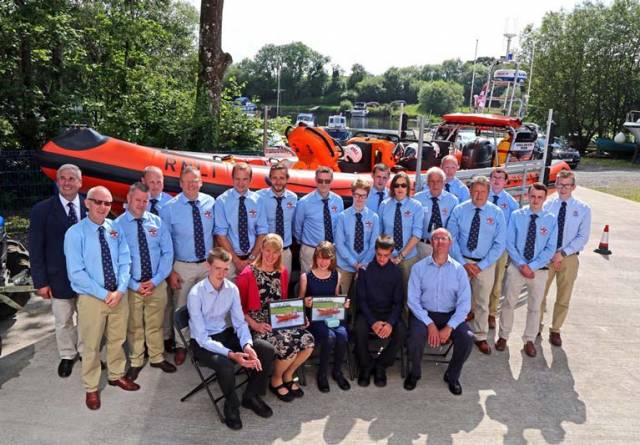At a special naming ceremony and service of dedication held today (Saturday 9 June), Carrybridge RNLI officially named its new Atlantic 85 class lifeboat, Douglas, Euan & Kay Richards, at the lifeboat station on Upper Lough Erne.
The honour of handing over the lifeboat and officially naming her went to Dr Barbara Stewart who represented the donor, and to Kay, one of Dr Stewart’s three children who the lifeboat is named after.
The lifeboat which went on service last November was funded by The John and Elizabeth Allan Memorial Trust.
The inshore lifeboat which is now located at Carrybridge and which has launched 13 times since going on service, was officially named Douglas, Euan & Kay Richards.
During the naming ceremony, Christopher Brooke, member of the RNLI Council of Ireland, accepted the lifeboat on behalf of the charity, before handing her over into the care of Carrybridge Lifeboat Station. Sam McCreery, Station President, accepted the lifeboat on behalf of the crew.
Mr McCreery said the event was a proud day for the lifeboat station adding that the crew were most grateful to The John and Elizabeth Memorial Trust for the generous gift which had funded the lifeboat.
On accepting the new lifeboat, Mr McCreery acknowledged the service of the station’s outgoing Atlantic 75 class lifeboat Duckhams 2001, which while on service at Carrybridge RNLI launched 64 times and brought 113 people to safety.
‘While we’re sad to say farewell to Duckhams 2001, the Atlantic 75, which has served the station faithfully for two and a half years,’ he said, we look forward to writing a new chapter in the station’s history with the arrival of this new B class Atlantic lifeboat.
Looking forward, Mr McCreery explained that the new lifeboat, an Atlantic 85, was the third generation B class lifeboat to be built, capable of speeds up to 35 knots. Fast, manoeuvrable, agile and versatile, it came with all the qualities of its predecessors but more.
He went on to explain how the lifeboat was ideally suited to rescues close to the shore and could withstand challenging conditions on inland waterways such as Lough Erne, making it an exemplary search and rescue craft.
The Atlantic 85, he told those gathered, had quicker response times, more space for casualty recovery and was able to carry an extra crew member.
‘The Atlantic 85,’ he said, ‘along with the Rescue Water Craft will be well suited to the waters of Upper Lough Erne because of the complex maize of islands which it will have to navigate using state of the art navigation equipment. Its range of cover from Belturbet to Enniskillen is a total of 26 miles.
‘This B class Atlantic 85 lifeboat means that we now have the latest and finest rescue equipment available. I know that when the crew head out on the water for training or on a shout, we’ll all have peace of mind that this lifeboat will help to keep them safe.’
The service of dedication that followed was led by Canon Mark Watson. The lifeboat was then officially named by Dr Barbara Stewart and her daughter Kay.
A crowd of well-wishers turned up to see the lifeboat officially named with a bottle of champagne poured over the side of the boat before it launched at the end of the ceremony.
Among the guests on the platform party were Tom Bailey, Carrybridge RNLI Lifeboat Operations Manager, who welcomed guests and opened proceedings, Dr Barbara Stewart, donor representative who handed the lifeboat into the care of the RNLI, Christopher Brooke, member of the RNLI Council of Ireland who accepted the lifeboat on behalf of the RNLI and handed it over into the care of Carrybridge Lifeboat Station, Sam McCreery, Station President who accepted the lifeboat on behalf of the crew, Canon Mark Watson, and Kay Richards who along with her mother Dr Barbara Stewart, formally named the lifeboat, and Archie Birrell, Chair of the Lough Erne Fundraising Group who delivered a vote of thanks and closed the ceremony.































































